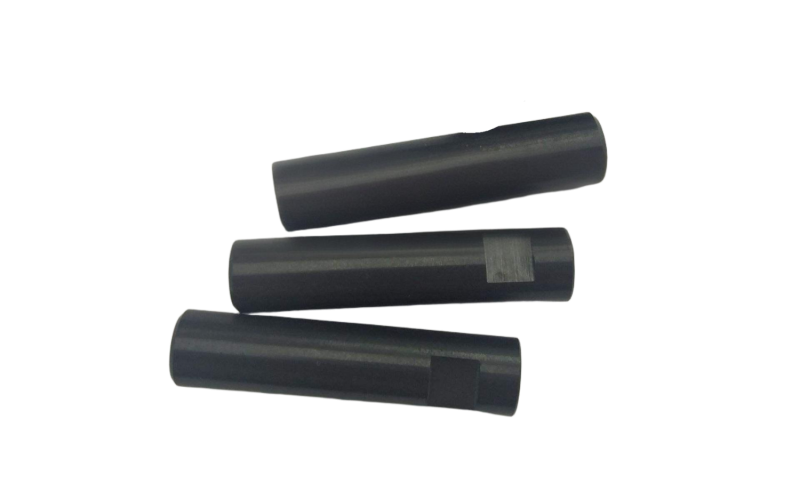Table of Contents
Why Silicon Carbide Rods Rock!
| Cool Feature | Why It’s Awesome |
|---|---|
| Super Hard | Almost as tough as diamonds! |
| Loves Heat | Works great up to 1625°C. |
| Chemical Proof | Doesn’t get hurt by acids. |
| Long-Lasting | Keeps working for ages! |
Need Tough Parts? Silicon carbide rods from Eshino Precision are perfect for hot and heavy jobs!
Introduction to Silicon Carbide Rods
What Are Silicon Carbide Rods?
Silicon carbide rods are like super-strong sticks made from a special material called silicon carbide, or SiC. This stuff is so tough it’s sometimes called carborundum! These rods are used in really hot places, like ovens that melt metal, or in machines that need strong parts. At Eshino Precision, we make silicon carbide rods to help all kinds of industries work better.
Why Are They Important?
These rods are important because they can handle crazy heat and tough conditions. For example, they can stay strong in temperatures up to 1625°C! Plus, they don’t wear out easily or get damaged by chemicals. This makes them perfect for things like electronics or cars. They’re like the superheroes of machine parts!
Who Uses Them?
Lots of industries love silicon carbide rods. People who make computer chips use them in super-hot furnaces. Car makers use them for strong parts that last a long time. Even companies that melt glass or metal rely on these rods. At Eshino Precision, we make sure our silicon carbide rods are just right for each job.
“Silicon carbide rods are unmatched for high-temperature durability, making them essential in modern industry.” – Dr. Sarah Thompson, Materials Engineer
Essential Properties of Silicon Carbide Rods
What Makes Them Special?
Silicon carbide rods have some amazing features. First, they’re super hard, almost like diamonds! Also, they can carry heat really well, which is great for hot jobs. Plus, they don’t change shape when heated, so they stay steady. These qualities make them awesome for high-temperature work.
Cool Features List
- Super Hard: Rated at 2800 HV, they’re tough as nails for hard-wearing parts.
- Heat Lover: Works great up to 1625°C, perfect for semiconductor furnaces.
- Chemical Shield: Stands up to acids and other nasty stuff, ideal for chemical plants.
- Heat Mover: Moves heat fast (320-348 W/m·K), great for heating jobs.
- Steady Shape: Barely expands when hot, so it stays in place.
Comparing Different Types
Not every silicon carbide rod is the same. Some, like Hexoloy® SA, are big and strong for heavy jobs. Others, like Hexoloy® SE, are made for super-precise parts. Here’s a table to show how silicon carbide compares to other materials:
| Feature | Silicon Carbide | Alumina | Zirconia |
|---|---|---|---|
| Hardness (HV) | 2800 | 1500 | 1200 |
| Heat Conductivity (W/m·K) | 320-348 | 30 | 2-3 |
| Max Temperature (°C) | 1600 | 1750 | 2400 |
Want more details? Visit our silicon carbide page!
Key Applications of Silicon Carbide Rods
Heating Up the Scene
Silicon carbide rods are superstars in hot places. They’re often used as heating elements in big ovens called furnaces. These rods can get as hot as 1625°C without breaking! For example, they help make computer chips in semiconductor factories. They’re also used to melt glass or fire pottery in kilns.
Strong Machine Parts
Besides heating, silicon carbide rods make tough machine parts. They’re used in things like seals that stop leaks or bearings that handle heavy loads. Their strength makes them great for oil drilling tools or chemical plants.
Where They Shine
- Electronics: Heating chips and circuits. See our electronics guide.
- Cars: Strong parts for engines. Check our automotive ceramics post.
- Metal Work: Melting metals in furnaces.
- Glass Making: Keeping heat steady for perfect glass.

Silicon Carbide Rod for Furnaces

Silicon Carbide Shaft for Pumps
Advantages of Silicon Carbide Rods Over Alternatives
Why They’re Better
Silicon carbide rods are awesome because they last a long time and handle tough jobs. They can work in super-hot places without breaking down. Also, they form a special layer that protects them from rusting. This makes them great for oxidation-resistant parts.
Vs. Other Materials
Compared to alumina rods, silicon carbide rods move heat better and don’t crack from sudden temperature changes. Against zirconia, they’re much harder, though not as tough. Unlike metals, they don’t rust or conduct electricity, which is perfect for chemical resistance. See our comparison guide.
Saving Money
Silicon carbide rods might cost more at first, but they save money over time. Because they last so long, you don’t need to replace them often. This is a big win for companies using cost-saving ceramics. At Eshino Precision, we make sure you get the best value!
Guide to Selecting Silicon Carbide Rods
What to Think About First
Choosing the right silicon carbide rod is like picking the best tool for a job. First, you need to know what your project needs. For example, does it need to get super hot? Or does it need to be super strong? By figuring this out, you can pick the perfect rod. At Eshino Precision, we help you choose the best one.
For Heating Jobs
If you’re using silicon carbide rods to heat things, like in a furnace, think about a few things. First, check the temperature—can it reach 1625°C? Also, what’s the air like? Some rods work better in air, others in special gases. Plus, make sure the rod’s size fits your oven. Finally, check the power it needs to work right. This keeps your furnace running smoothly!
For Machine Parts
If you need silicon carbide rods for machine parts, like seals or bearings, focus on strength. They need to handle heavy loads or rough conditions, like in oil drilling. Also, make sure they’re super precise, with sizes as exact as ±0.01mm. At Eshino Precision, we make rods that fit perfectly.
Easy Checklist
- Know the Job: Is it for heating or a machine part? Match the rod to the task.
- Check Heat: Pick a rod that can handle your max temperature. See our heat resistance guide.
- Size It Right: Get the exact length and width for your setup.
- Think Environment: Make sure it resists chemicals or wear. Check our corrosion guide.
- Ask Experts: Eshino Precision can help! Visit our material selection page.
“Picking the right silicon carbide rod can boost efficiency and cut costs in high-heat applications.” – Dr. Michael Chen, Ceramic Technology Specialist
Manufacturing Process of Silicon Carbide Rods
How Are They Made?
Making a silicon carbide rod is like building a super-strong toy! It takes special steps to get it just right. At Eshino Precision, we follow a careful process to make sure every silicon carbide rod is tough and perfect for jobs like tubes or valves.
Step-by-Step
- Start with Powder: We use super-pure silicon carbide powder and mix it with helpers called binders.
- Shape It: The powder is pressed or squeezed into a rod shape, like making a clay stick.
- Bake It Hot: The rod is heated to 2200°C in a special oven. This makes it super strong!
- Make It Smooth: We polish the rod to be super exact and smooth, perfect for reliable parts.
- Check It: Every rod is tested to make sure it’s strong and works perfectly.
Why It’s Tricky
Making silicon carbide rods is hard because they need to be perfect. For heating rods, we use a special trick called recrystallization to make them carry electricity better. For machine parts, we might mix in extra silicon to make them tougher. At Eshino Precision, we use top machines to get it right. Learn more in our manufacturing guide.

Market Trends and Insights
Why Are They Popular?
Silicon carbide rods are getting more popular because they’re so tough and useful. Industries like electronics and cars use them a lot. Also, new ways to make them are making them even better for things like solar panels. The market for these rods is growing fast!
Market Numbers
The market for silicon carbide heating rods was worth $118 million in 2024. By 2025, it’s expected to hit $123.78 million, growing at 4.9% a year. By 2030, it could reach $157.4 million! Here’s a quick look:
| Year | Market Size (USD Million) | Growth Rate |
|---|---|---|
| 2024 | 118 | – |
| 2025 | 123.78 | 4.9% |
| 2030 | 157.4 | 4.9% |
What’s Driving Growth?
More companies want parts that last longer and work in tough spots. Silicon carbide rods are perfect for this. They’re also used in new tech, like ceramic substrates for electronics. At Eshino Precision, we’re ready to meet this demand. Read more in our ceramics impact guide.
Frequently Asked Questions (FAQs)
What Are Silicon Carbide Rods Used For?
What Are Their Properties?
Silicon carbide rods are super hard (2800 HV), move heat well (320-348 W/m·K), resist chemicals, and handle heat up to 1625°C.
How Are They Made?
They start as powder, get shaped into rods, baked at 2200°C, and polished to be perfect for precision jobs.
What’s Better About Them?
They last long, love heat, resist rust, and move heat fast, saving money over time. See our silicon carbide guide.
How Do I Pick One?
For heating, check heat and size. For parts, focus on strength and fit. Eshino Precision helps! Visit our selection guide.
How Are They Different from Alumina or Zirconia?
They move heat better than alumina and are harder than zirconia. Check our comparison.
What’s the Market Like?
It’s growing at 4.9% a year, hitting $123.78 million in 2025, thanks to demand in tech and cars.
Conclusion
Why Silicon Carbide Rods Are Great
Silicon carbide rods are like super-tough helpers for machines and furnaces! They’re hard, handle crazy heat, and last a long time. Whether you’re making computer chips, cars, or glass, these rods from Eshino Precision make your work better. Plus, with the market growing, now’s the time to use them!
External Resources
- Kyocera: Silicon Carbide Properties – Explore SiC’s technical specs.
- Saint-Gobain: Silicon Carbide Applications – Learn about industrial uses.
- Precision Ceramics: SiC Overview – Compare ceramics for your project.
Ready to Transform Your Engineering Solutions?
Want stronger, longer-lasting parts? Eshino Precision’s silicon carbide rods are ready for you! Contact us now to find the perfect rod for your project. Check out our products page or reach out for a custom solution. Let’s make your machines awesome!

